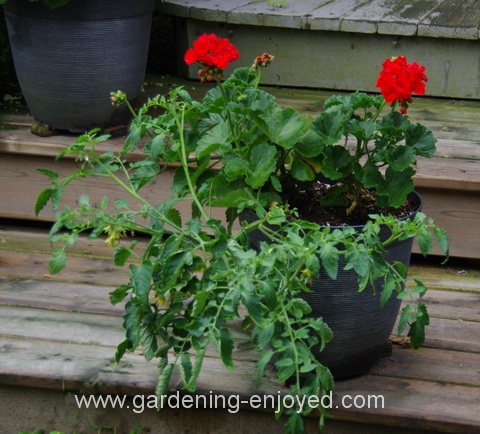
Pots of red Geraniums have graced our front steps for several years so this year we thought we would change it up a bit. I had a few Tumbler Tomatoes to plant somewhere and joining the Geraniums just seemed like a good idea. The Tomatoes certainly liked the idea. They are rapidly overtaking the Geraniums and I have started to prune them. They are called Tumbler because they are supposed to tumble or cascade down the front of the container. Apparently they need a little encouragement. Hopefully their little green Tomatoes will soon be a lovely matching red for the Geranium flowers. So far it appears to be a successful way to grow delicious food in a delightful way.
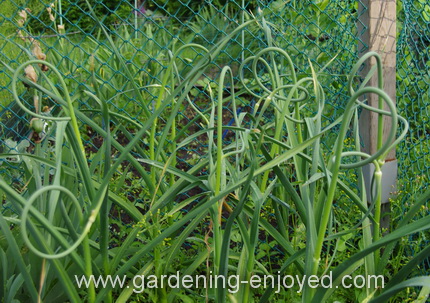
Garlic scapes develop into the most fascinating shapes. They make interesting additions to floral design work but there are much better reasons for harvesting them. Chopped into stir fry they add a great flavour. When I have a quantity of them I throw them in the food processor and make pesto, to keep us enjoying that flavour for several months. It freezes quite well. The Garlic cloves developing at the base of those plants will get much bigger if the plant doesn’t have to put energy into developing the scape and its bulbils. Those bulbils that develop in the flower structure near the top of the scape are another reason to remove that scape. They will land on the ground and start to grow little Garlic plants that you will come to see as persistent weeds. Each Garlic plant can produce in excess of 100 bulbils and they would take 3 - 5 years to develop into useful garlic. Cut them, cook them and enjoy' it’s so
much better than digging them out of your beds.
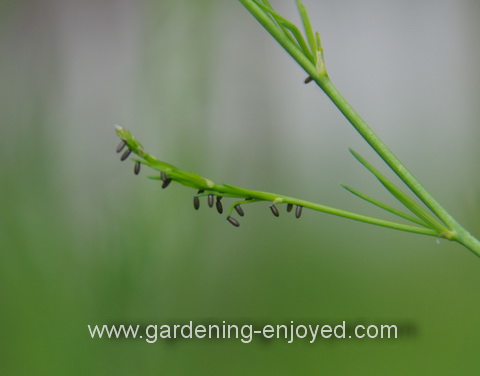
I showed you a picture of some Asparagus Beetles in the last issue. They seem to be very prolific this year, probably Mother Nature’s way of making up for the very small number of Red Lily Beetles. This picture is an egg mass from one of the Aspargus beetles and if you can find and remove these it’s much easier and less messy than removing the larva as they are munching away. These eggs seem to be quite large and I think they are just starting to emerge as the larval form. Look for rows of little black dots like these on the Asparagus fern and wipe them off with a thumbnail. Mechanical control is mostly how I fight these nasties but some insecticidal soap might work on the larva.
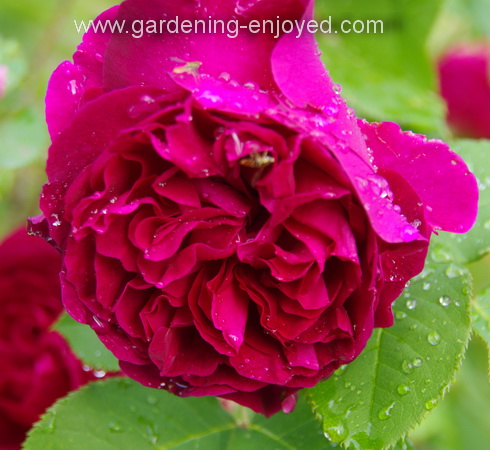
My Roses seem to be having a good year. They like to be well watered and that has certainly been no problem this spring. I have several David Austin Roses and they are in the middle of putting on a great show. This dark wine coloured one is Munstead Wood and I particularly like its colour. One of my trellis is covered with the cream/pink flowers of The Albrighton Rambler. I try to obtain the varieties that are grown on their own roots rather than the grafted ones. I find them hardier in my part of the world. They do get a few soakings of liquid fertilizer throughout the spring and early summer to keep them blooming longer. Some of them tend to have weak stems that allows the large blooms to bend over a bit but they tell me to fertilize a bit more to try to correct that problem. I just have to remember to do that early enough in the season to have some effect. Procrastination has always been one of my favourite
activities and this spring’s weather has made it easier to do.
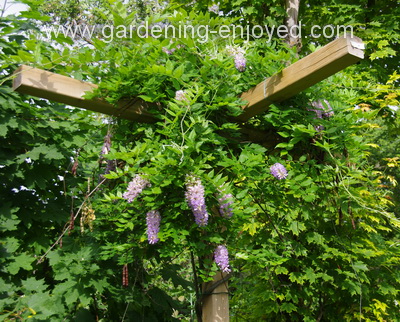
This is another of my great ideas that seems to remain unfinished. I wanted a Wisteria tree and I seemed to have created one that is blooming quite nicely right now. All of the vines are bunched up in the centre. Those arms of 4 x 4 that are protruding are supposed to be covered with vines. Apparently the Wisteria needs to be encouraged to grow out there. The next step is to drill some holes in those arms and create a web of wire between them so that the vines have something to hang on to. Even then I suspect that I will need to get my ladder out and prune and train those vines to get my desired result. My somewhat useless right arm, this spring, has precluded any such activity. Maybe as a fall project so that it will be ready to provide a wider show of blooms next spring.
Now it’s time to answer a few of my reader’s questions. To ask a question just “reply” to this ezine. Don’t forget
to check the front page of the Website for frequent short ideas for current gardening activities.
Sharon Asks? Have you ever used Slug B Gone around hostas & if so , did it work?
Ken Answers! I have used it around emerging beans and Morning Glories with some success but my Hosta don't seem to have a slug problem.
Valerie Asks? I have a bin that I have been putting compost in for a year now. What do I do with all the fruit and vegetables that are filling the bin. How are they used now?
Ken Answers! The secret to a good compost is to have two bins. If you turn the contents of the first into the second then leave it to turn into nice black compost while you continue to fill the first. Use the compost in your garden and then you can repeat the cycle.
Mary Jane Asks? Will my small (1 – 2 inches) Echinacea seedlings, which
have self seeded in my garden, bloom this year?
Ken Answers! Echinacea can grow quite quickly so there is a good chance that it will bloom in the first year.





